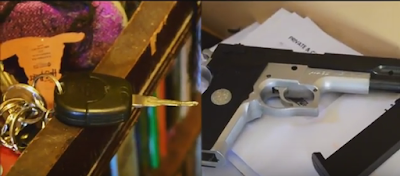The above GIF image is an example of the editing technique match-on action: Kaden is visualised walking down a corridor for our preliminary task. This action is shown from two camera perspectives; from the corridor itself, and from within the 'interview room'. One thing I would alter, if given the opportunity, is change the match-on action to Kaden opening the door. I consider this a more visually interesting match-on action in comparison to a person walking down a corridor. Furthermore, there is a delay when the perspective of the camera changes to that of inside the interview room; Kaden's character appears further away from the door than he does in the previous shot.
Above is an example of match on-action from our finished media product. As you can see, the match-on action is of Kaden and Ty's characters leaving their homes via the front door. Our use of this editing technique has improved from the preliminary task because we ensured that the transition from one camera perspective to another was perfectly timed. Therefore, this avoided a continuity error because the scene continued to flow. Also, the match-on action of two mysterious characters opening/closing a door was more compelling in comparison to the match-on action of a person walking down a corridor.
The above screen grab shows a shot/reverse shot of Kaden's character being interviewed by Ty's character during the preliminary task. A limitation of our use of the shot/reverse shot is that the sound is ineffectively asynchronous to the movements on screen during the scene in which Ty is mocking Kaden. Therefore, this conveys the conversation between the characters as artificial.
During our actual thriller opening, we did not use dialogue to ensure that our opening sequence is ambiguous and enigmatic. However, we did use a non-dietetic musical score. Variations in the pitch, tone, volume and rate of the music were used in conjunction to the scene. For example, when Kaden's character points a gun towards Ty's character, the music stops completely and a gun shot is heard. Ultimately, parallel sound matched to the action onscreen enabled us, as a production crew, to build up suspense when appropriate.
Once edited, it appeared that we had obeyed the 180-degree rule during this scene (above) of the preliminary task. We ensured that the camera did not move more than 180 degrees (half a circle) around the characters. However, the cameraman misplaced the camera during filming which meant that we unintentionally had disobeyed the continuity rule. Fortunately, we were able to mirror the footage during the editing phase of the film. This gave the impression that the camera was in fact placed in an appropriate position.
Our actual thriller film opening did not feature characters in diegetic dialogue. Therefore, the 180-degree rule was not technically used. However, part of our opening contained Kaden and Ty walking towards a car (prop). Therefore, we ensured that the camera did not move more than 180 degrees (half a circle) around the car (above). This was improvement upon the preliminary task because we did not have to flip any footage in order to obey the 180-degree rule.
 |
| A close-up of a gun |
In the preliminary task, camera shots were used basically (e.g., a medium close-up of characters' faces). However, for our actual thriller film opening, we were more experienced. Therefore, shot types were used creatively to appeal to our target audience (e.g, a close-up of props such as a gun (to build tension)).
Finally, after experimenting and becoming confident with editing techniques, we decided to use a split-screen special effect for our final media product. The split-screen was effective in juxtaposing characters and their actions (e.g. on the left-hand side of the screen, Ty, a college student, grabs his car keys, whilst on the right-hand side, Kaden, an assassin, grabs a gun.)
 |
| An example of the split-screen special effect in action |




No comments:
Post a Comment